The Type 88, also referred as the PGZ-88, was a self-propelled anti-aircraft gun, first was revealed in 1989. Developed since the early 1980s it was fully-automatic, but only a 24 were built for evaluation trials; It was never accepted for service nor exported but helped pave the way for better systems like the Type 95 and Type 07. As of today these vehicles has been displayed and stored, kept in reserve or scrapped.
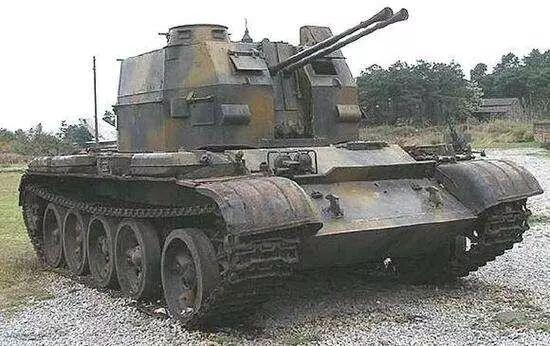
China also developed another SPAAG in the early 1980s: The Chinese (illegal) version of the Soviet ZSU-57-2 "Sparka", the most common 1960s SPAAG, widely exported. N licence was ever agreed with China after the late 1950s cooldown and 1969 war, so the PRC, which was interested to give an organic SPAAG to armoured units, found a solution. The People's Republic of China was approached by Iraq indeed, in the early 1980s, to develop a copy of the ZSU-57-2 system.
Saddam Hussein had indeed purchased 100 from USSR in 1970, from which a few were delivered to the PRC for reverse-engineering. To meet Iraq's production order, NORINCO tried to just replicate the system on a basis already produced in China, the improved amphibious chassis of the Type 69-II light tank. This vehicle was called the Type 80 SPAAG, tested and accepted for PLA service in small numbers and intended for export but failed to attact any order, including Iraq. Nevertheless in bewteen they were able to create their own proximity fuses to modernize the S-60 and S-68 ammunitions and which met large success.
However a Chinese soure claims thos obtained were also from Egypt. Because of the lack of experience, but with a very urgent task, the method of walking on two legs was adopted, first, to acquire a set of ZSU-23-4 from Egypt, disassemble them for study. At the same time try to adapt on a type 59 tank chassis the existing Chinese 37mm anti-aircraft gun in a twin mount for research and development, to see if something with ready-made technology can be released fast.
To the PRC, the emergency to built a SPAAG was both for AA cover and to provide strong ground support. The type 65 twin 37mm imitated from Soviet models in the 1950s, no matter how the rate of fire or ballistic performance were changed, would still not be comparable to the benchmark "Yenisei" twin 37 mm self-propelled AA gun. This Type 76 naval model had just been successfully developed at that time came and was now available for further developments after being largely adopted by the Chinese PLAN.
From this basis, it was decided to radically improve over the design and create a totally locally developed SPAAG. One goal was to introduce a high level of automation in the firing mechanism and fast reload, something which needed to scrap the existing slow-firing 57 mm and replaced them by more modern 37 mm guns. This led to a radical redesign of the Type 80 SPAAG, which still shared many components.
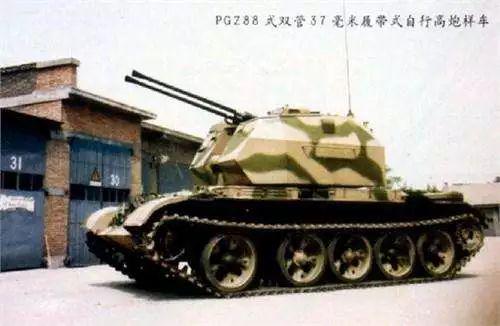
In 1983, progress was done on the Type 80, based on the Type 59 chassis, and the team involved in the development found that although the size was correct, the power required notably for the full rotation of the artillery and the fire control system were beyond the capabilities of the powerplant in the Type 59 chassis can provide.
Fortunately, at the time, the Type 69 main battle tank was improved to the Type 69-3, fitted with components from the Type 79 unveiled in the 1984 military parade, so the chassis assembly of the Type 79 plus the transmission box of the Type 73 tank repair vehicle could be sourced for the new tailored chassis. In parralel, the new Navy type 76 37 mm gun was also thought for adoption.
The Type 76 and its fully enclosed turret 76A plus manually operated 76F system were however in 1985 taxed of backwardness compared with other systems, but at that time, this still was a high-speed automatic reload system which was in addition self-developed with all-Chinese electric firing mechanism, radar fire control system, barrels and new ammunitions. The marriage with the new modified Type 79 chasis seemed evident at that point.
The 1983 system developed as a test prototype still lacked a proper radar, its shooting accuracy met or even exceed target requirements of the PLA, at the shooting range. On paper, any aircraft/helicopter moving at less than 3,000 meters was easy meat for the 37mm tracer anti-personnel shells and any direct hit was enough for a kill, still relyning on the "Eyeball Mark I". After all, many ZSU-57-2 still seeing combat at the time claimed enemy planes and helicopters, notably during the Iran-Iraq war or in Lebanon. The 1983 prototype was finally qualified in 1985.
In 1986, a new prototype was designed around a first on-board radar that could withstand high speeds runs over rough terrain. The 497 Factory (Chongqing Wangjiang Machinery Factory) produced four prototype vehicles with this FCS, handed over to the test site. It was found the radar was efficient until a maximum distance of 15 kilometers, and can intercept in a fully stabilize dmode a fast moving target at 8,000 meters and sent to target bursts of 30 shells a minute. The radar could even track the taret while the chassis was on a very bumpy road. The behaviour of the chassis was found very satisfying in this regard. The whole artillery system has been also much improved and largely was better than the old Shuang 37 weapon system.
The new SPAAG participated in the 1986 Beijing Defense Exhibition. At that time, the 40th anniversary of the National Day military parade also showcased it, and the general staff quickly agreed to have it included in the "8910" project, asking the manufacturer to produce 20 more to be delivered at the Beijing Military Region test dept. for a general review. As a relatively small-scale unit, Factory 497 was enthralled to proceed on schedule.
After raising funds to purchase equipment needed, unit 497 soon completed the 20 prototype, with the right quality needed. However "8910" program was never completed, and the attitude of the army at this time became suspcicious of the new SPAAG, also poised to do budget adjustments. Therefore, if the Type 88 was finalized in November 1986, ready for mass production, the army only ordered 4 more vehicles before the 497 497 factory's military product line was closed.
Although there were indeed many teething issues still with the Type 88 like its overall reliability compared to, for example, the twin Oerlikon 35 mm, the new SPAAG was lacking the required level. By the 1990s However, self-propelled anti-aircraft systems still did not had an organic, dedicated command vehicle, reducing the chances to fight independently and deal with new air threats. After the 24 vehicles delivered to the special academy of the Beijing Military Region, army leaders felt how comfortable it was to have 30 square kilometers of mobile air cover for the armored troops in exercises. On one hand, this allowed further development of the Type 95/04 four barreled 25mm SPAAG and contributed to the birth the Type 07 35mm, but it made the Type 88 eventually a mere field demonstrator.
The Type 74 guns had a Rate of Fire of 380 rds/min sustained, at a 7,200 m range. Elevation was - 5 to + 85 degrees for a 360 degrees traverse. The Type 88 is fitted with surveillance radar, folding backwards, with also optical sights and an electro-optical director, plus a ballistic computer and a friend or foe identification system. Detection range is over 15 km, max 3 km altitude. Reaction time after spotting a target was estimated 6-11 seconds. It was tested in all-weather, and for day and night operations, although without proper IR device for spotting and targeting. In all, 1,000 rounds are also carried, mostly fuse type HE rounds and tracer rounds.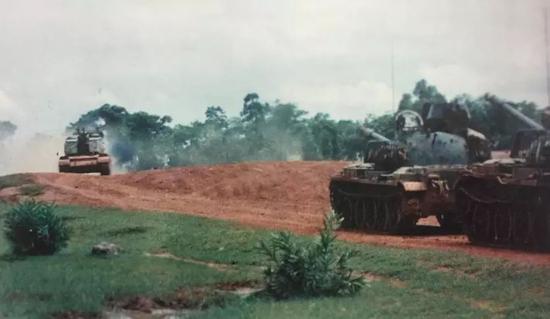
The new vehicle was called 88式自行高射炮; pinyin: bābā shì zìxíng gāoshèpào or "Type 88 self-propelled anti-aircraft artillery". It was only used in the People's Liberation Army for limited evaluation trials and the fate of surviving vehicles today is hard to find. A composite brigade of the 82nd Group Army, formerly last armored division of the Chinese Army before the military reforms, which in a footage clearly shows a Type 88 SPAAG is one example of survival.
From preparation against Taiwan this substitute self-propelled twin 25mm was still used by many units in training. The Type 07 was planned for more heavy-duty special brigades. Today the Type 88 is still around for training recruits in several units and often seen in footage to this day.
mil.news.sina.com.cn
odin.tradoc.army.mil
army-guide.com
globalsecurity.org
Development
The only SAAG developed in China in early years was the Type 65 ➚ twin 37mm model based on the T-34/85 tank chassis created for the help of Vietnam. The PRC never adopted it as unsatisfied with the model, and already thoight of adapting a new variant on the more modern chassis of the 62-type light tank. The self-propelled anti-aircraft vehicle named "301" had a new 37 mm anti-aircraft gun and fire control radar according to the plan. But still, there will be many years before this happen.
China also developed another SPAAG in the early 1980s: The Chinese (illegal) version of the Soviet ZSU-57-2 "Sparka", the most common 1960s SPAAG, widely exported. N licence was ever agreed with China after the late 1950s cooldown and 1969 war, so the PRC, which was interested to give an organic SPAAG to armoured units, found a solution. The People's Republic of China was approached by Iraq indeed, in the early 1980s, to develop a copy of the ZSU-57-2 system.
Saddam Hussein had indeed purchased 100 from USSR in 1970, from which a few were delivered to the PRC for reverse-engineering. To meet Iraq's production order, NORINCO tried to just replicate the system on a basis already produced in China, the improved amphibious chassis of the Type 69-II light tank. This vehicle was called the Type 80 SPAAG, tested and accepted for PLA service in small numbers and intended for export but failed to attact any order, including Iraq. Nevertheless in bewteen they were able to create their own proximity fuses to modernize the S-60 and S-68 ammunitions and which met large success.
However a Chinese soure claims thos obtained were also from Egypt. Because of the lack of experience, but with a very urgent task, the method of walking on two legs was adopted, first, to acquire a set of ZSU-23-4 from Egypt, disassemble them for study. At the same time try to adapt on a type 59 tank chassis the existing Chinese 37mm anti-aircraft gun in a twin mount for research and development, to see if something with ready-made technology can be released fast.
To the PRC, the emergency to built a SPAAG was both for AA cover and to provide strong ground support. The type 65 twin 37mm imitated from Soviet models in the 1950s, no matter how the rate of fire or ballistic performance were changed, would still not be comparable to the benchmark "Yenisei" twin 37 mm self-propelled AA gun. This Type 76 naval model had just been successfully developed at that time came and was now available for further developments after being largely adopted by the Chinese PLAN.
From this basis, it was decided to radically improve over the design and create a totally locally developed SPAAG. One goal was to introduce a high level of automation in the firing mechanism and fast reload, something which needed to scrap the existing slow-firing 57 mm and replaced them by more modern 37 mm guns. This led to a radical redesign of the Type 80 SPAAG, which still shared many components.

In 1983, progress was done on the Type 80, based on the Type 59 chassis, and the team involved in the development found that although the size was correct, the power required notably for the full rotation of the artillery and the fire control system were beyond the capabilities of the powerplant in the Type 59 chassis can provide.
Fortunately, at the time, the Type 69 main battle tank was improved to the Type 69-3, fitted with components from the Type 79 unveiled in the 1984 military parade, so the chassis assembly of the Type 79 plus the transmission box of the Type 73 tank repair vehicle could be sourced for the new tailored chassis. In parralel, the new Navy type 76 37 mm gun was also thought for adoption.
The Type 76 and its fully enclosed turret 76A plus manually operated 76F system were however in 1985 taxed of backwardness compared with other systems, but at that time, this still was a high-speed automatic reload system which was in addition self-developed with all-Chinese electric firing mechanism, radar fire control system, barrels and new ammunitions. The marriage with the new modified Type 79 chasis seemed evident at that point.
The 1983 system developed as a test prototype still lacked a proper radar, its shooting accuracy met or even exceed target requirements of the PLA, at the shooting range. On paper, any aircraft/helicopter moving at less than 3,000 meters was easy meat for the 37mm tracer anti-personnel shells and any direct hit was enough for a kill, still relyning on the "Eyeball Mark I". After all, many ZSU-57-2 still seeing combat at the time claimed enemy planes and helicopters, notably during the Iran-Iraq war or in Lebanon. The 1983 prototype was finally qualified in 1985.
In 1986, a new prototype was designed around a first on-board radar that could withstand high speeds runs over rough terrain. The 497 Factory (Chongqing Wangjiang Machinery Factory) produced four prototype vehicles with this FCS, handed over to the test site. It was found the radar was efficient until a maximum distance of 15 kilometers, and can intercept in a fully stabilize dmode a fast moving target at 8,000 meters and sent to target bursts of 30 shells a minute. The radar could even track the taret while the chassis was on a very bumpy road. The behaviour of the chassis was found very satisfying in this regard. The whole artillery system has been also much improved and largely was better than the old Shuang 37 weapon system.
The new SPAAG participated in the 1986 Beijing Defense Exhibition. At that time, the 40th anniversary of the National Day military parade also showcased it, and the general staff quickly agreed to have it included in the "8910" project, asking the manufacturer to produce 20 more to be delivered at the Beijing Military Region test dept. for a general review. As a relatively small-scale unit, Factory 497 was enthralled to proceed on schedule.
After raising funds to purchase equipment needed, unit 497 soon completed the 20 prototype, with the right quality needed. However "8910" program was never completed, and the attitude of the army at this time became suspcicious of the new SPAAG, also poised to do budget adjustments. Therefore, if the Type 88 was finalized in November 1986, ready for mass production, the army only ordered 4 more vehicles before the 497 497 factory's military product line was closed.
Although there were indeed many teething issues still with the Type 88 like its overall reliability compared to, for example, the twin Oerlikon 35 mm, the new SPAAG was lacking the required level. By the 1990s However, self-propelled anti-aircraft systems still did not had an organic, dedicated command vehicle, reducing the chances to fight independently and deal with new air threats. After the 24 vehicles delivered to the special academy of the Beijing Military Region, army leaders felt how comfortable it was to have 30 square kilometers of mobile air cover for the armored troops in exercises. On one hand, this allowed further development of the Type 95/04 four barreled 25mm SPAAG and contributed to the birth the Type 07 35mm, but it made the Type 88 eventually a mere field demonstrator.
Design
Hull and general design
As said above, over a Type 79 chassis, modified, is placed a larger open turret with sloped sides housing the twin barrel and two operators. Since reload is automatic, they only are charged of tracking targets (radar operator) and firing (gunner) in a hunter-killer mode, under orders of a commander which cooridnated with other vehicles in the unit. It weight approximatively 35 tons.Engine and performances
The Type 88 SPAAG possessed the Type 79 chassis, housing a diesel engine, developing 570 hp. It could achieve a range estimated to 500 km, and 50 kph on flat. When tested it was found ablt to climb a Gradient of 60%, a side Slope of 30°, one meter vertical Step, cross a 2 meters trench gap, and ford rivers up to 1.2 meters, but it's not amphibious and would be at risk with its open turret, so no preparations are even planned.Protection
Armor was similar to the type 79 for the chassis, and about 15 mm on the frontal arc for the main turret (estimated caliber for most light vehicles, and APCs). There aare not smoke projectors carried for active protection, and no NBC system.Armament
The Type 88 SPAAG is armed with two 37 mm guns, derived from the Type 74 towed twin 37 mm anti-aircraft gun and naval systems. It is fitted with a fully automatic loader and there ae wo firing setups, against against ground targets and light armored vehicles and AA fire, fully stabilized on 3 axis. This was the only armament apart personal weapons aboard. The gun could be set in a single or burst mode, from one or both barrels. Shells exited the barrels at a muzzle velocity of 1,000m/s.The Type 74 guns had a Rate of Fire of 380 rds/min sustained, at a 7,200 m range. Elevation was - 5 to + 85 degrees for a 360 degrees traverse. The Type 88 is fitted with surveillance radar, folding backwards, with also optical sights and an electro-optical director, plus a ballistic computer and a friend or foe identification system. Detection range is over 15 km, max 3 km altitude. Reaction time after spotting a target was estimated 6-11 seconds. It was tested in all-weather, and for day and night operations, although without proper IR device for spotting and targeting. In all, 1,000 rounds are also carried, mostly fuse type HE rounds and tracer rounds.
Service

The new vehicle was called 88式自行高射炮; pinyin: bābā shì zìxíng gāoshèpào or "Type 88 self-propelled anti-aircraft artillery". It was only used in the People's Liberation Army for limited evaluation trials and the fate of surviving vehicles today is hard to find. A composite brigade of the 82nd Group Army, formerly last armored division of the Chinese Army before the military reforms, which in a footage clearly shows a Type 88 SPAAG is one example of survival.
From preparation against Taiwan this substitute self-propelled twin 25mm was still used by many units in training. The Type 07 was planned for more heavy-duty special brigades. Today the Type 88 is still around for training recruits in several units and often seen in footage to this day.
Specifications PGZ-88 | |
| Dimensions | As Type 79 chasis, circa 3.50 turret. |
| Total weight, battle ready | 35.1 tons |
| Crew | 4 (driver, commander, gunner, tracker) |
| Propulsion | 570 hp diesel |
| Suspension | Tracked chassis, 5 roadwheels, idler, drive sprocket, torsion bars suspensions |
| Speed (road) | 50 km/h (30 mph) |
| Range | 500 km (370 mi) |
| Armament | 2x 37 mm Type 75 AA |
| Armor | Unknown, small arms fire and shrapnel |
| Total production | 62 in 1971-1972 |
Links
military-today.commil.news.sina.com.cn
odin.tradoc.army.mil
army-guide.com
globalsecurity.org

The Type 80 SPAAG intended for Iraq, to compare
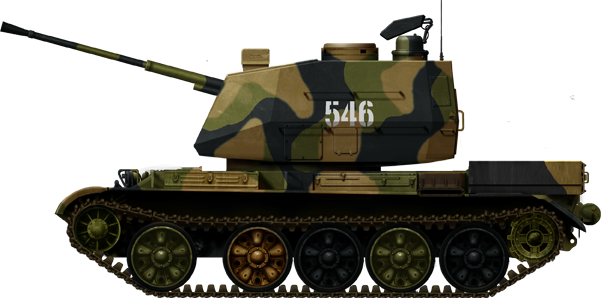
Type 88 SPAAG in classic PRC tritone camouflage, 1990s.
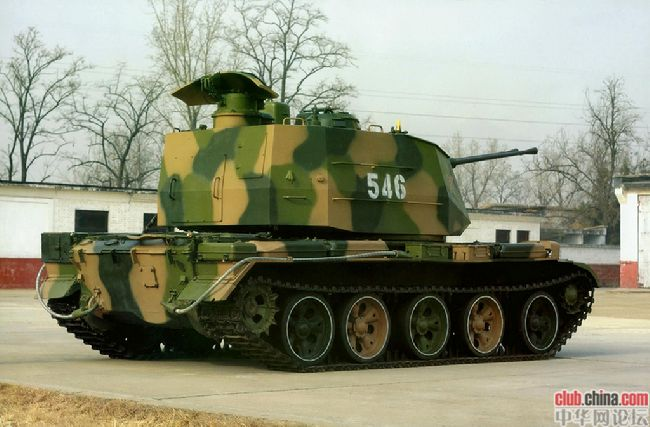
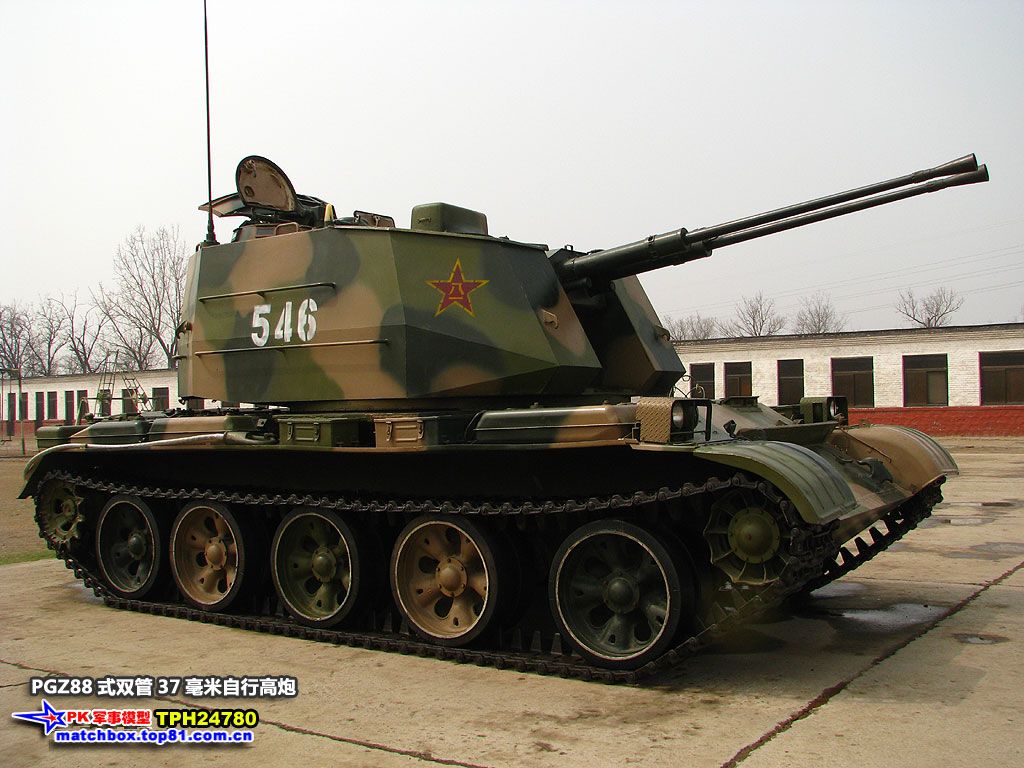
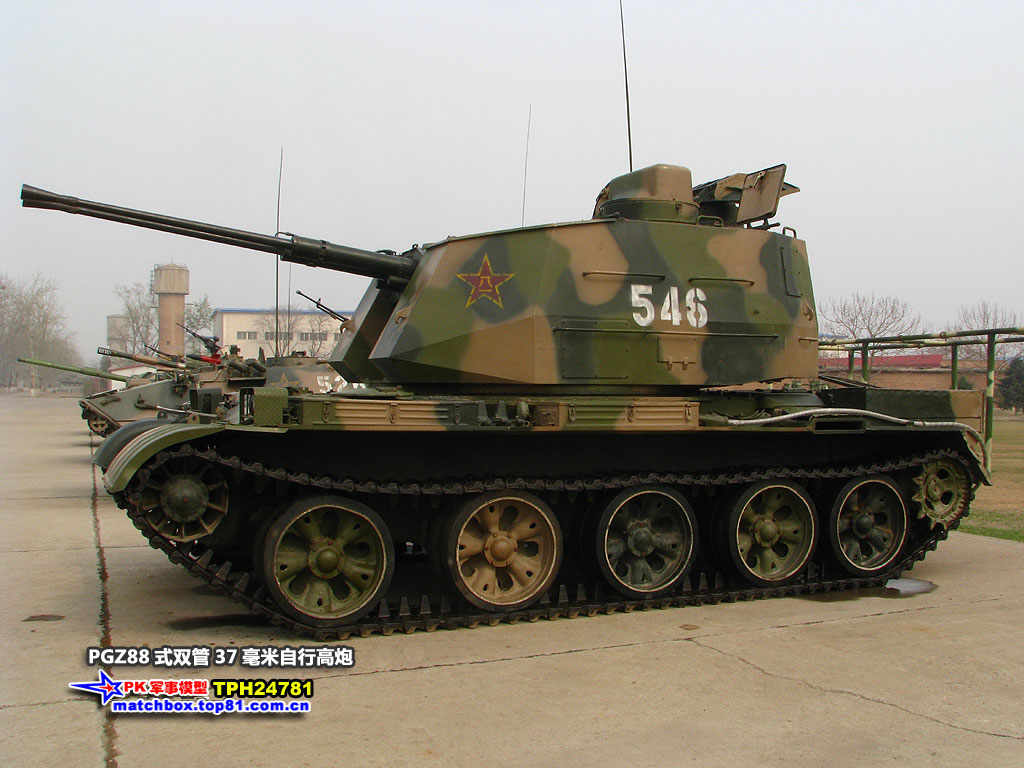
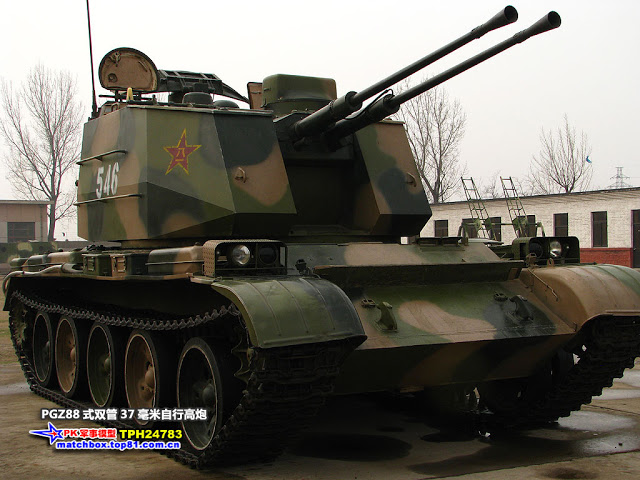
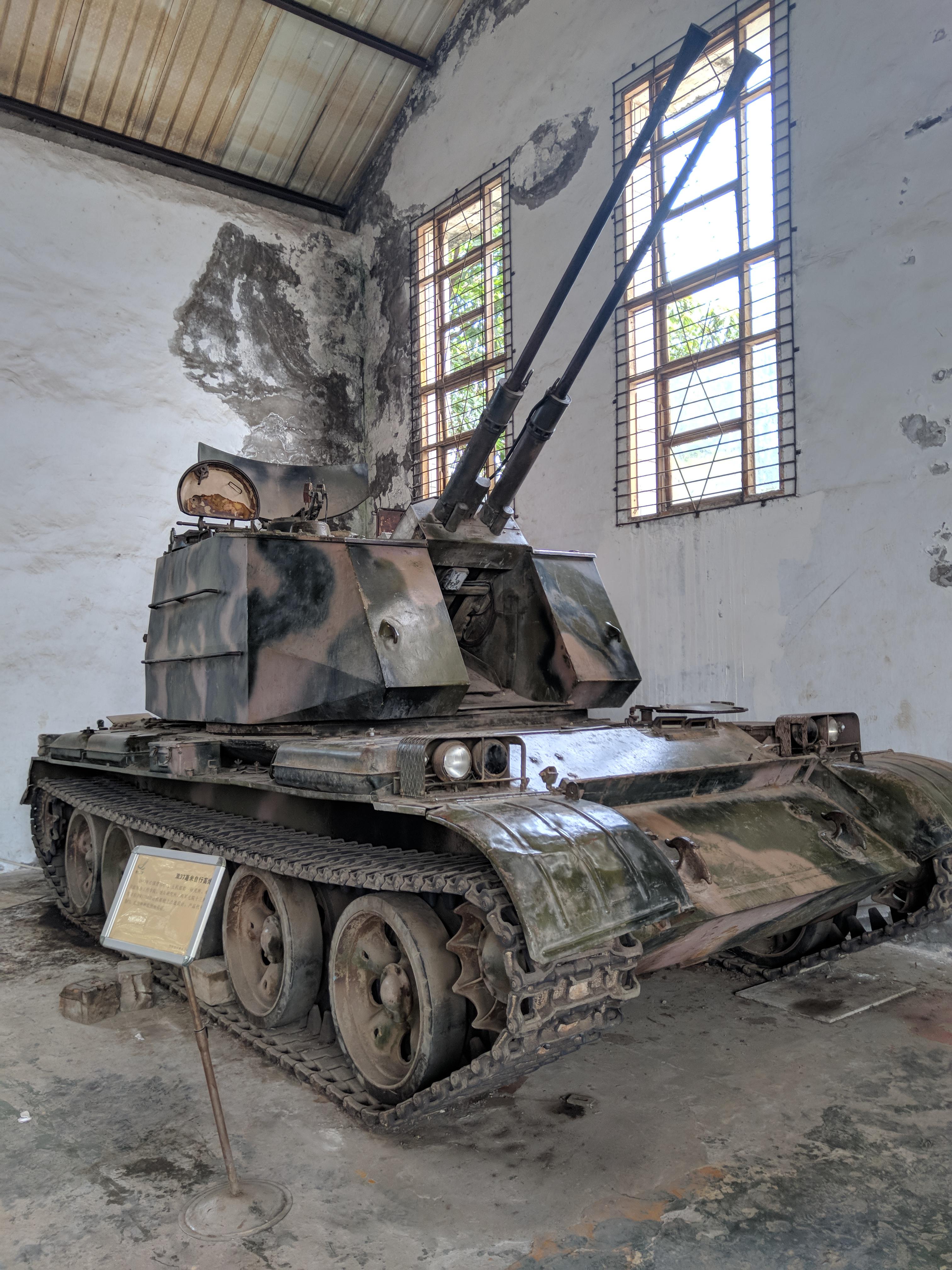
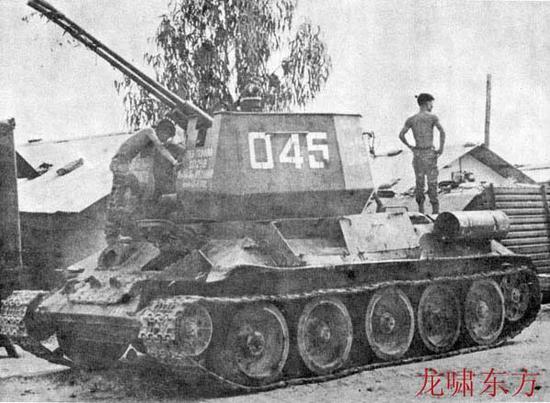
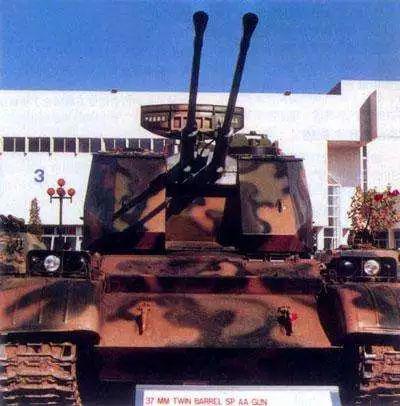
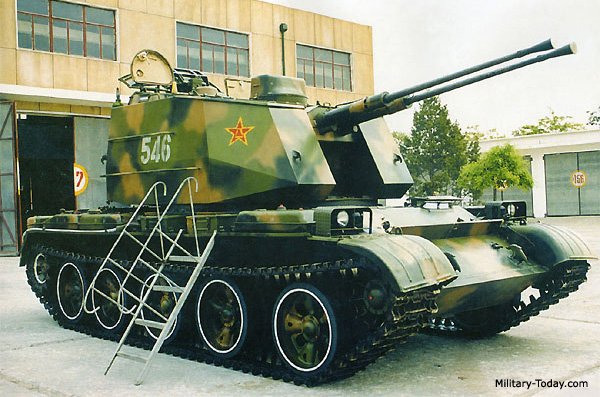

Cold War Tanks


































Cold war tanks posters

Cold War Main Battle Tanks

Cold War Soviet Army

